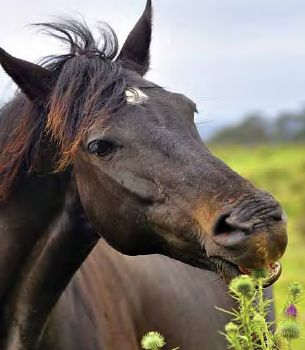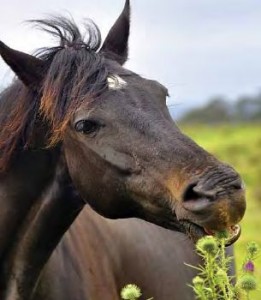Get Growing!

 Planting A Medicinal Herb Garden For Your Horse.
Planting A Medicinal Herb Garden For Your Horse.
Before horses were domesticated, they roamed free and kept themselves healthy by grazing on a large variety of plants. They used their deeply-ingrained instincts to seek out the plants they needed to maintain their health. A wealth of herbal knowledge was acquired by ancient herders who spent their lives watching the animals in their charge seek out certain plants at different times according to their needs. This information was handed down through many generations.
THE BENEFITS OF HAVING YOUR OWN GARDEN
Cut and dried herbs can be very expensive to purchase, but they are often very easy and inexpensive to grow yourself. Growing an herb garden for your horse will give you the ability to harvest fresh herbs whenever you need them. The herbs can be dried and stored for later use, or made into tinctures or extracts that can be given orally or added to various equine grooming and health products.
Many herbs offer wonderful health benefits for horses when added to feed rations, or by allowing the animals to graze on the fresh plants. Herbs can be a beneficial addition to hoof oils, poultices, wound, skin and coat products, and insect repellents. Planting herbs around the barn can also repel insects. Garlic, geraniums, lavender, rue and wormwood planted near stables and pastures can help control overpopulations of bothersome bugs. Also useful for repelling insects are eucalyptus, citronella, lemongrass and tea tree – these herbs are often used in all-natural insect repellents and applied externally to help repel flies, mosquitos and other pests.
Top 8 Herbs for Your Garden:
1. Aloe Vera (Aloe barbadensis)
Aloes are semi-tropical succulent plants. They can be grown outdoors in climates where there is no chance of freezing (USDA Zones 10 to 11). Aloe vera is relatively easy to grow indoors if given sufficient light. If grown outdoors, it should be planted in full sun or light shade. The plant is fairly drought-tolerant, but some water should be provided. Watering should be minimal in the winter when the plant becomes somewhat dormant. In the summer, the soil should be soaked and allowed to dry completely before watering again.
Parts used: Juice or gel from the leaves.
Use: The gel soothes itchy dry skin and heal burns and wounds.
Cautions: This plant should be used externally only. Do not let horses ingest it, as it is a strong purgative.
2. Arnica (Arnica montana)
This perennial herb is native to continental Europe. It is also known as leopard’s bane, mountain tobacco, and mountain arnica. Arnica montana is a member of the aster family, and is closely related to the sunflower and daisy. The plant reaches heights of 12” to 24”; it is hardy and can be grown successfully in Zones 4 to 9. It grows best in full sun, but can do well in partial shade. The stems carry single yellow/orange flowers from mid-spring to the end of summer. The plant can be slow to start from seed but can be propagated by division or from cuttings.
Parts used: Roots and dried flowers.
Use: Apply it externally for musculoskeletal injuries such as sprains, strains, bruises and sore muscles. Arnica stimulates blood circulation and specifically stimulates the action of white blood cells to relieve congested blood and trapped fluids from bruised tissues. Its anti-inflammatory and anti-bacterial qualities can help reduce pain and swelling and improve healing. It is an excellent addition to hoof treatments to prevent and treat bruised soles and sensitive hooves.
Cautions: The plant contains some toxins and should not be taken internally. Arnica may also be toxic when used on open wounds for long periods.
3. Calendula (Calendula officinalis)
Also known as pot marigold, calendula is an essential part of your medicinal garden. It can grow to almost 24” in height, displays bright yellow/orange flowers, and prefers full sun or partial shade.
Parts used: Flowers.
Use: Entire flower heads can be used in preparations for healing cuts, scrapes, burns, insect bites and irritated skin. Calendula has antiseptic and anti-inflammatory properties. It is my first choice for the topical treatment of wounds.
Cautions: Do not give internally unless under the supervision of a qualified herbalist.
4. Chamomile (Matricaria recutita)
An annual with small, daisy like flowers, chamomile is native to Europe and naturalized in North America. It is a relative of the sunflower and has a sweet characteristic smell. Chamomile seeds are among the few that need light to germinate, so growing can be a delicate process. Chamomile can be planted outdoors by broadcasting the seeds and mixing them very lightly with soil after all chance of frost has past. Seeds can also be started indoors and then transplanted outside after a hardening-off period. Once the plants are established, chamomile is very hardy. It prefers full sun but can tolerate partial shade.
Parts used: Fresh or dried flowers.
Use: Chamomile has anti-inflammatory, relaxant, analgesic (pain relieving), anti-fungal, anti-allergy, tissue-healing and antibacterial properties. The German Commission E has approved chamomile for external use in supporting skin care and inflammation, with several clinical trials supporting its efficacy. Chamomile is used for burns, ulcers, wounds, skin sensitivity and for enhancing coat appearance. Its anti-inflammatory action can be attributed to the natural chemicals alpha bisbolol and chamazulene contained within the flower; they have the ability to inhibit arachidonic acid metabolism. Chamomile’s ability to relieve pain may be due to a prostaglandin-inhibiting action.
Cautions: In rare instances, chamomile may cause an allergic sensitivity in susceptible individuals.
5. Comfrey (Symphytum officinalis)
This perennial herb originated in Europe. Comfrey is a hardy plant that can grow in a wide range of climates. It does best in USDA Zones 3 to 9, but will grow almost anywhere. Comfrey is most easily propagated from root cuttings and needs three-foot spacing for proper root development.
Parts used: Root and main rib of leaf.
Use: Applied externally for contusions, sprains, wounds, burns, and inflammatory skin disorders. Comfrey decreases healing time and acts as a mild analgesic.
Cautions: Should not be used internally without the guidance of a qualified herbalist.
6. Dandelion (Taraxacum officinalis)
Like arnica, the dandelion is another plant in the Asteraceae or aster family. Often considered a weed, dandelions actually have some amazing health benefits. They are a wealthy source of many nutrients including vitamins A, B, C, D, potassium, calcium, manganese, sodium, sulfur and choline. You probably don’t need to do much to grow dandelions and will very likely find them growing on their own.
Parts used: Whole plant, leaves, flowers, roots.
Use: The dandelion stimulates liver function and bile production, as well as pancreas and kidney function. It is highly beneficial to the digestive system as a whole. Dandelion cleans the blood and stimulates excretion processes. It makes an excellent spring tonic and can be a great plant for horses to graze on during rehabilitation and conditioning. Dandelion is a very effective diuretic, and is also used for rheumatism, arthritis, laminitis, and as a mild laxative.
Cautions: Because many people consider dandelions a weed, exercise caution when harvesting them or allowing horses to graze on them – be sure they have not been treated with pesticides.
7. Echinacea (Echinacea purpurea)
Another member of the aster family that’s also known as coneflower, Echinacea is native to the central and eastern United States. It adds color to the garden, blooming with purplish-pink flower heads accented by a raised disk center. It is best to plant Echinacea in spring or fall. It’s very tolerant of heat, humidity and dry conditions. This plant attracts butterflies to the garden.
Parts used: Mostly roots, and seeds/flowers.
Use: Echinacea has immune-dilating, anti-inflammatory, anti-viral, antibacterial, and anti-fungal properties. It is used to increase white blood cell production in the blood and helps clear infection from the body. Can be given dried or as a vinegar extract.
Cautions: Echinacea is possibly contraindicated in cases of autoimmune diseases and cancer.
8. Peppermint (Mentha piperita)
More than 25 species of mint are grown around the world. Peppermint is distinguished by its square stem with a reddish hue. It prefers partial shade but will grow in full sun. Because it spreads vigorously by underground runners, you may prefer to grow it in containers so it doesn’t take over your garden. Peppermint is usually not grown from seed, but propagated from roots or runners.
Parts used: Leaves
Use: Peppermint can be added to horse feeds to make them more palatable. It has a beneficial effect on the digestive system and helps soothe the GI tract. The oils in peppermint can also be added to skin and coat products to alleviate and cool dry itchy skin.
Cautions: No known contraindications.
Important Tips:
Try growing common local herbs and “weeds” first, as these will likely be the easiest to grow. “One man’s weed is another man’s herbal treasure” – for example, the dandelion!
Always check the botanical or Latin name of an herb before planting it or giving it to your horse. Closely related herbs can have very different effects. One could have great benefits and another could be poisonous.
The appropriate type of herb and its dosage are critical to the safety of your horse. Consult an expert herbalist to ensure safety and efficacy.
It is important to remember that some herbs are banned in competition, and to check your organization’s list of banned substances before administering any herbs before an event.
By Sara Murdoch & Re-posted from Equine Wellness Magazine
Sara Murdoch is the owner and founder of The Equine Apothecary. The Equine Apothecary specializes in all natural health and grooming products for horses. Their products are botanically based products that feature herbal extracts and essential oils and are formulated using the principles of herbalism and aromatherapy. Sara is a lifelong horsewoman with a degree in Equine Science with a Science Concentration from Colorado State University. Sara was also a Registered Veterinary Technician for 10 years. TheEquineApothecary.com
